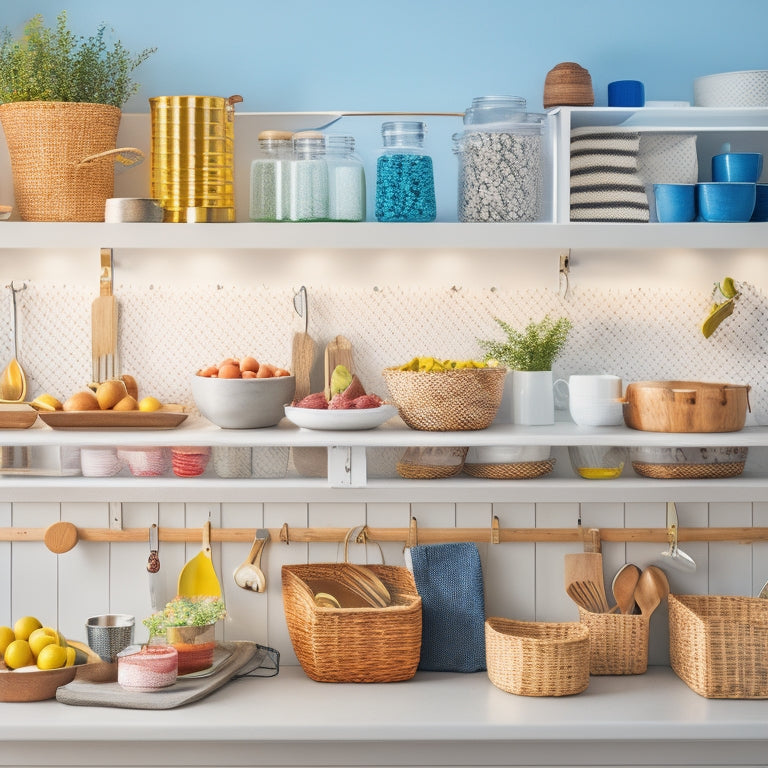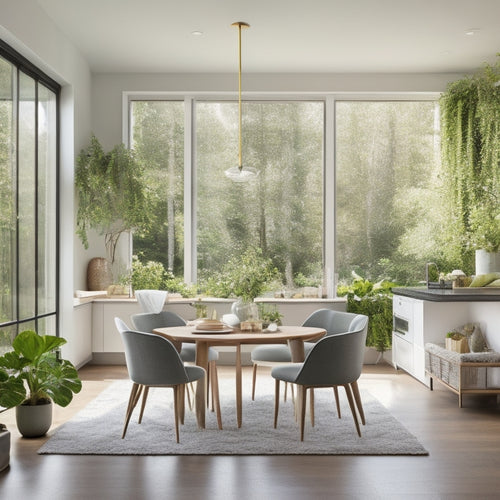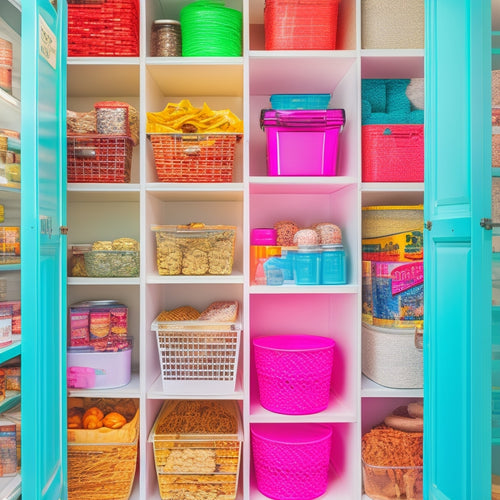
7 Budget-Friendly Hacks for Family Kitchen Organization
Share
To get your kitchen organized on a budget, start by utilizing vertical storage spaces with shelves, hooks, and pegboards to maximize your walls. Repurpose everyday items like mason jars and picture frames to create functional storage solutions. Label and categorize your contents with clear font styles and color coding for easy identification. Create a centralized spice station and optimize corner cabinet space with carousels and lazy Susans. Designate specific areas for each family member and implement a 'One In, One Out' rule to maintain your new space. Get ready to discover even more hacks to transform your kitchen from chaotic to clutter-free.
Key Takeaways
• Utilize vertical storage spaces by installing shelves, hooks, or a pegboard to maximize kitchen organization on a budget.
• Repurpose everyday items like mason jars, wooden crates, and picture frames to create functional storage solutions without spending a dime.
• Label and categorize contents using clear, stackable, and durable containers to simplify kitchen organization and reduce clutter.
• Create a spice station with a designated area and a budget-friendly spice rack to keep spices organized and within easy reach.
• Designate specific areas for each family member's belongings and implement a 'One In, One Out' rule to maintain a clutter-free kitchen.
Utilize Vertical Storage Spaces
Maximize your kitchen's potential by installing shelves, hooks, or a pegboard on walls and ceilings to free up countertops and floor space. This will create a more open and inviting atmosphere, perfect for family bonding.
High shelves are ideal for storing infrequently used items like special occasion dishes or cookbooks. Label each shelf so you can easily find what you need.
Ceiling racks are great for hanging pots, pans, and utensils, keeping them organized and within reach. You can also use them to store less frequently used kitchen gadgets, like a stand mixer or food processor.
By utilizing vertical storage spaces, you'll be able to see everything at a glance, making meal prep and cooking a breeze. Plus, it'll keep your countertops clear, giving you more room to create and enjoy quality time with your family.
Repurpose Everyday Items
As you tackle kitchen organization, don't overlook the treasures hiding in plain sight. You can breathe new life into everyday items, turning them into functional storage solutions that'll keep your kitchen running smoothly.
Turn Trash to Treasure
By thinking creatively, you can transform items you'd normally toss into useful tools that'll keep your kitchen organized and clutter-free. This concept is all about upcycled decor and creative reuse.
Instead of throwing away items, get innovative and turn them into functional pieces that'll elevate your kitchen's style and functionality.
Here are some ideas to get you started:
-
Turn old mason jars into utensil holders or vases for fresh herbs.
-
Use a wooden crate as a storage container for kitchen gadgets or as a rustic shelving unit.
-
Transform an old picture frame into a chalkboard for meal planning or a magnetic board for notes and reminders.
Magnetic Spice Strips
You can also breathe new life into metal strips from old calendars or notebooks by turning them into magnetic spice strips that'll keep your spices organized and within easy reach. Simply glue small magnets to the back of the strips, and attach them to a metal surface, like your fridge or a metal cabinet.
Then, stick your spice containers to the strips, and voilà! You've got a functional and space-saving spice rotation system.
This hack not only keeps your spices organized but also adds a touch of industrial chic to your kitchen aesthetics. Plus, it's easy to swap out spices as needed, ensuring you always have the freshest flavors on hand.
To take it to the next level, label each strip with the corresponding spice name, and you'll be whipping up meals like a pro in no time. With this budget-friendly hack, you'll be amazed at how much more efficient your kitchen becomes.
Use Old Containers
Three old containers you likely have lying around - empty jars, plastic containers, and cardboard boxes - can be repurposed to store kitchen essentials like coffee filters, twist ties, and food wraps, keeping them out of the way but still easily accessible. This is an easy and budget-friendly way to give your kitchen a makeover without breaking the bank.
You can transform these containers into useful storage vessels with a few simple steps. Here's how:
-
Clean and disinfect: Give the containers a good wash and dry them thoroughly to remove any residue or germs.
-
Label and categorize: Use a marker to label each container with its contents and group similar items together.
-
Assign a home: Designate a specific spot in your kitchen for each container, making it easy to find what you need when you need it.
Label and Categorize Contents
Now that you've repurposed everyday items to maximize your kitchen's storage capacity, it's time to guarantee you can easily find what you need when you need it.
To do this, you'll want to identify the storage containers you're using and simplify your label designs.
Identify Storage Containers
Start by gathering all the storage containers you've accumulated over time, from plastic bins to ceramic jars, and sort them into categories like baking supplies, cooking utensils, and pantry staples. This will help you see what you have and what you need.
As you sort, consider the characteristics that make a container ideal for kitchen storage. You'll want containers that are:
- Clear Containers: allowing you to see what's inside without having to dig through
- Stackable Options: maximizing your storage space and keeping your kitchen countertops clutter-free
- Durable: able to withstand the wear and tear of daily use.
Simplify Label Designs
Simplify Label Designs
With your storage containers sorted and categorized, you're ready to assign a home for each item and make it easily identifiable with a simple yet effective labeling system. This is where color coding and font styles come into play. A consistent labeling system will help you and your family members quickly find what you need, reducing clutter and stress in the kitchen.
Here's a labeling guide to get you started:
| Label Element | Description | Tips |
|---|---|---|
| Font Style | Choose a clear, easy-to-read font like Arial or Helvetica | Use a font size between 18-24 points for best visibility |
| Color Coding | Assign a specific color to each category (e.g., baking, cooking, snacks) | Use bright, contrasting colors to make labels pop |
| Label Content | Keep labels concise and descriptive (e.g., 'Gluten-Free Flours' or 'Pantry Staples') | Avoid using abbreviations or acronyms that might confuse family members |
Create a Spice Station
Designate a specific area in your kitchen, such as a cabinet, drawer, or countertop, to serve as a centralized spice station that keeps your seasonings organized and within easy reach. This dedicated space will help you quickly find the right spice to elevate your dishes, saving you time and frustration.
To create an efficient spice station, consider the following:
-
Invest in a spice rack that fits your designated space, ensuring easy access to your most-used seasonings. You can opt for a wall-mounted, countertop, or magnetic spice rack, depending on your kitchen layout.
-
Group your spices by flavor profiles, such as baking, savory, or spicy, to simplify meal prep and inspire new recipes.
-
Store less frequently used spices in a separate container or on a higher shelf, keeping your everyday essentials front and center.
Maximize Corner Cabinet Space
Make the most of the often-wasted space in your corner cabinet by installing a carousel or lazy Susan, allowing you to easily access and utilize the entire area. This simple hack will transform your corner cabinet into a functional storage space, making it easy to find what you need when you need it.
Next, consider adding corner shelves to maximize the vertical space in your corner cabinet. These shelves will provide additional storage for infrequently used items, keeping them out of the way but still accessible.
Don't forget about those pesky blind corners – the areas where two cabinets meet, creating a dead space. Use a blind corner organizer or a basket to store items like spices, oils, or cleaning supplies, keeping them hidden from view but still within reach.
Designate a Launching Pad
As you've optimized your corner cabinet space, now turn your attention to creating a designated launching pad where everyone in the household can place their belongings, such as backpacks, keys, and mail, keeping clutter at bay and making mornings smoother. This designated spot will become the hub of your morning routine, helping you stay on track and guarantee a stress-free start to the day.
To create an effective launching pad, consider the following:
-
Assign a specific spot: Designate a specific area, such as a hook, tray, or bin, for each family member to place their belongings.
-
Keep essentials within reach: Store daily essentials like keys, wallets, and bags in easy-to-access locations to save time and reduce morning chaos.
-
Create a daily checklist: Create a visual reminder of tasks to complete each morning, such as packing lunches or grabbing water bottles, to help everyone stay on track and develop a sense of responsibility.
Implement a "One In, One Out" Rule
By adopting a 'one in, one out' rule, you'll maintain a balanced amount of possessions in your kitchen, ensuring that every new item that enters your space replaces an old one, keeping clutter under control and your kitchen organized. This rule promotes clutter accountability, as you're forced to ponder the value of each new item and the space it'll occupy.
It's also an effective habit formation technique, as you'll develop a mindset of intentional consumption and mindful possession.
To implement this rule, start by evaluating your current kitchen inventory. Get rid of items that are no longer serving a purpose or are broken beyond repair. Then, set a rule for yourself: for every new kitchen item you bring in, remove or donate an old one. This will maintain a sense of balance and prevent clutter from building up again.
Frequently Asked Questions
How Do I Keep My Kitchen Organization Systems From Getting Cluttered Again?
To maintain your kitchen's organization, you'll identify and address clutter triggers, then create habits to counter them, like daily tidying and weekly deep cleans, ensuring your systems stay clutter-free and functional for your family's needs.
Can I Use These Hacks in a Small Kitchen With Limited Space?
"Good things come in small packages," right? You can absolutely use these space-saving hacks in your tiny kitchen. Opt for compact solutions like wall-mounted shelves, collapsible containers, and multi-functional appliances to maximize your limited space.
Are These Organization Methods Suitable for Families With Young Children?
When organizing your kitchen with young children, you'll want to prioritize childproofing strategies and create toddler-friendly zones, making it easy for them to participate and learn while keeping them safe from hazards.
How Often Should I Clean and Maintain My Kitchen Organization Systems?
You'll want to maintain your kitchen organization systems by incorporating daily schedules for quick tidies and seasonal refreshes to deep clean and reassess your setup, ensuring everything stays functional and clutter-free for your family.
Can I Customize These Hacks to Fit My Personal Kitchen Style?
You crave a kitchen that reflects your unique charm, and the good news is you can customize these hacks to fit your personal preferences by incorporating design elements that make your heart skip a beat.
Related Posts
-

Family Harmony Achieved: Doral Home Renovation Unveiled
We designed our Doral home renovation around a simple yet powerful idea: that a unified, open space can bring our fam...
-

Revamp Your Pantry With Dollar Store Hacks
You can transform your pantry from a cluttered disaster zone to a sleek and functional space with just a few trips to...

